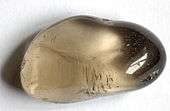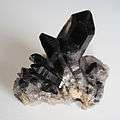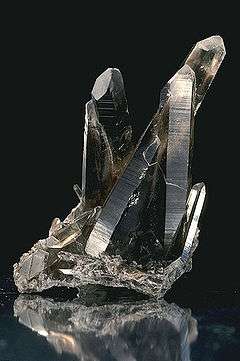Smoky quartz
| Smoky quartz | |
|---|---|
|
Smoky quartz | |
| General | |
| Category | oxide mineral |
| Formula (repeating unit) | SiO2 |
| Strunz classification | 04.DA.05 |
| Dana classification | 75.01.03.01 |
| Crystal system | α-quartz: trigonal trapezohedral class 3 2; β-quartz: hexagonal 622[1] |
| Space group | Trigonal 32 |
| Unit cell | a = 4.9133 Å, c = 5.4053 Å; Z=3 |
| Identification | |
| Colour | Brown to grey, opaque |
| Crystal habit | 6-sided prism ending in 6-sided pyramid (typical), drusy, fine-grained to microcrystalline, massive |
| Twinning | Common Dauphine law, Brazil law and Japan law |
| Cleavage | {0110} Indistinct |
| Fracture | Conchoidal |
| Tenacity | Brittle |
| Mohs scale hardness | 7 – lower in impure varieties (defining mineral) |
| Lustre | Vitreous – waxy to dull when massive |
| Streak | White |
| Diaphaneity | Transparent to nearly opaque |
| Specific gravity | 2.65; variable 2.59–2.63 in impure varieties |
| Optical properties | Uniaxial (+) |
| Refractive index |
nω = 1.543–1.545 nε = 1.552–1.554 |
| Birefringence | +0.009 (B-G interval) |
| Pleochroism | None |
| Melting point | 1670 °C (β tridymite) 1713 °C (β cristobalite)[1] |
| Solubility | Insoluble at STP; 1 ppmmass at 400 °C and 500 lb/in2 to 2600 ppmmass at 500 °C and 1500 lb/in2[1] |
| Other characteristics | Piezoelectric, may be triboluminescent, chiral (hence optically active if not racemic) |
| References | [2][3][4][5] |
Smoky quartz is a grey, translucent variety of quartz. It ranges in clarity from almost complete transparency to a brownish-gray crystal that is almost opaque. Some can also be black.[6] Like other quartz gems, it is a silicon dioxide crystal. The smoky colour results from free silicon, formed from the silicon dioxide by natural irradiation.
Varieties
Morion
A very dark brown to black opaque variety is known as morion. Morion is the German, Danish, Spanish and Polish synonym for smoky quartz.[7] The name is from a misreading of mormorion in Pliny the Elder.[8] It has a density of 5.4.
Cairngorm
Cairngorm is a variety of smoky quartz crystal found in the Cairngorm Mountains of Scotland. It usually has a smokey yellow-brown colour, though some specimens are a grey-brown.
It is used in Scottish jewellery and as a decoration on kilt pins and the handles of sgian dubhs (anglicised: skean dhu). The largest known cairngorm crystal is a 23.6 kg (52 pound) specimen kept at Braemar Castle.
Uses
Smoky quartz is common and was not historically important, but in recent times it has become a popular gemstone, especially for jewellery.[9]
Sunglasses, in the form of flat panes of smoky quartz, were used in China in the 12th century.[10]
Gallery
 Smoky quartz found in a stream
Smoky quartz found in a stream Morion variety
Morion variety
See also
References
- 1 2 3 Deer, W. A., R. A. Howie and J. Zussman, An Introduction to the Rock Forming Minerals, Logman, 1966, pp. 340–355 ISBN 0-582-44210-9
- ↑ Anthony, John W.; Bideaux, Richard A.; Bladh, Kenneth W.; Nichols, Monte C. (eds.). "Quartz". Handbook of Mineralogy (PDF). III (Halides, Hydroxides, Oxides). Chantilly, VA, US: Mineralogical Society of America. ISBN 0962209724.
- ↑ Quartz. Mindat.org. Retrieved on 2013-03-07.
- ↑ Quartz. Webmineral.com. Retrieved on 2013-03-07.
- ↑ Hurlbut, Cornelius S.; Klein, Cornelis (1985). Manual of Mineralogy (20 ed.). ISBN 0-471-80580-7.
- ↑ "Smoky Quartz: Smoky Quartz mineral information and data.".
- ↑ http://www.mindat.org/min-6270.html Morion on Mindat
- ↑ New Oxford American Dictionary (2nd ed., 2005), p. 1102.
- ↑ "The Gemstone Smoky Quartz". minerals.net. Retrieved 14 December 2015.
- ↑ Joseph Needham, Science & Civilisation in China (Cambridge, England: Cambridge University Press, 1962), volume IV, part 1, page 121. Needham states that dark glasses were worn by Chinese judges to hide their facial expressions during court proceedings.
| Wikisource has original text related to this article: |
- Holden, Edward (1925). "The Cause of Color in Smoky Quartz and Amethyst" in American Mineralologist, vol. 9, pp. 203–252
External links
| Wikimedia Commons has media related to Smoky quartz. |
